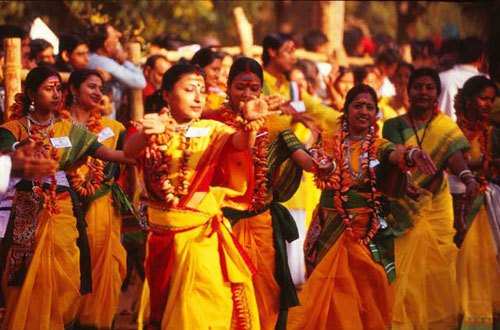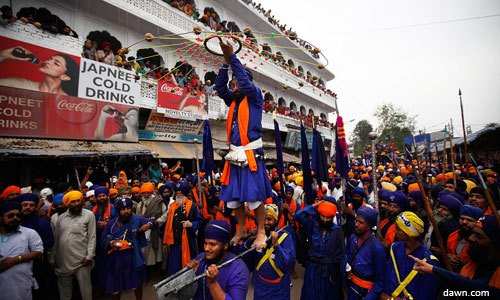The many Colors & Traditions of Holi in India
Holi, the most colorful and gaiety festival of all is celebrated with much fanfare in the country. Like wild fire, Holi is spreading its festive spirit all over the world as a spring celebration of love, colors and frolic.

Holi, the most colorful and gaiety festival of all is celebrated with much fanfare in the country. Like wild fire, Holi is spreading its festive spirit all over the world as a spring celebration of love, colors and frolic.
The Phalguna Poornima (Full Moon) day signifies the triumph of good over evil, arrival of spring, end of winter, to forgive and forget and to repair ruptured relationships over Gujiya, Bhaang, Thandai and bright colored Gulal.
Not just restricted to the Hindu community, the festival of Holi varies from region to region in India. This article will give you a virtual tour of far wide places and their ways of celebration.

Mathura and Vrindavana: The holy places where Lord Krishna spent most of his childhood celebrate the festival with most gusto. Situated in Uttar Pradesh, Holi spans for a week and more, started from February 27th this year. On 1st March the Bankebihari Temple in Vrindavana was the main attraction with hundreds of devotees celebrating the day with colors. The famous Lathmar Holi is celebrated in these places. Each temple houses the idols of Radha and Krishna.
Of particular interest is the city called Barsana, 42 Km from Mathura which is known to be the birthplace of Radha whereas Krishna hailed from Nandagaon. On Holi, men from Nandgaon visit Barsana to celebrate Holi with the women who in turn beat them with sticks, instead of gulal.

Haryana: The state celebrates with a human pyramid that tries to break the pot of buttermilk hung high with a rope in the streets of Haryana. Also a tradition of Hindu undivided family, known as Bhabhi-Devar Holi, the brother’s wife beats her brother-in-law with her sari rolled up as a rope in a mock rage. This tradition is followed in good humor where in the evening; brother in law brings sweets for her.

Maharashtra & Gujarat: Relieving the childhood of Krishna, the local men soaked in water and colors walk through the streets with a mock warning for all household to take care of butter pots. This refers to the habit of Krishna who used to steal butter and milk from pots.
Alongside, the human pyramid or human staircase is also made in the street to break the pot hanging from a rope at a height. It is said that the man who breaks the pot is the Holi King of the locality for that year. All these traditions are enacted as a tribute to Lord Krishna and his mischievous instances that have evolved now around Holi.
In Mahrasthra, this festival is celebrated on the 5th day after Holika Dahan and is known as Ranga Panchami.

Goa: As a part of Shigmo Spring Festival, the day is celebrated by farmers, laborers and rural population as a welcome to the Spring season. It is one of the major festivals of Hindus in Goa which is joined by many others.

Bengal: Holi goes by the name Dol Yatra in Bengal, or the swing festival. Traditionally a day celebrated with Krishna and Radha’s idols placed on swings where devotees with hymns and songs take turns to swing the idols. Women dance and men spray colored water and color called ‘Abeer’. However, the recent trends have subdued this tradition.
Basant Utsav commenced by Nobel Laureate Ravindra Nath Tagore was celebrated in Shantiniketan to celebrate the arrival of spring season with songs, dance, hymns and play with colors. Even today, now turned University, the students relive the tradition with fervor and many foreign tourists be the part of this festivity.

Purulia: 5-6 hours train journey away from Kolkata, this folk village celebrates Holi for 3 days. A wide variety of folk art is performed including remarkable Chau Dance, Darbari Jhumur, Natau Dance and songs of Baul. The special highlight of this festival is that it is entirely organized by villagers as a way to help sustain them.

Punjab: In the state of Punjab, the festival goes by the name Hola Mohalla and instead of colors, the residents demonstrate physical agility in forms of wrestling, martial art, mock sword fights, acrobatic military exercises and turban tying etc. This festival was commenced by Sikh Guru Gobind Singh in 1701 and is still celebrated with honor and pride.

Orissa: Similar to the tradition of Bengal, Orissa people place the idols of Jagannath instead of Krishna and Radha on the swing. This is because, Jagannath temple is at Puri, Orissa and Jagannath or the ‘Lord of the Universe’ is another name of Krishna.

Manipur: In here, Holi is a 6 day long festival which starts from the Full Moon day. With the introduction of Vaishnavism, the centuries old Yaoshang Festival merged with Holi in 18th century. Florescent lights, drums echo with folk songs on the moonlit night.
A thatched hut is made of twigs, hay and is burnt in the night. The next day, the boys in group go to girls to play with gulal and in return girls extract money from them for playing Holi.
Dressed in yellow and white turbans, the community members dance and play with gulal in front of the temple and sing devotional songs. On the last day, the community members take out a procession, 3 Km west from Imphal where various cultural performances are conducted.

Kumaon: The Kumaoni Holi goes by many names such as Baithaki Holi, Khadi Holi and Mahila Holi. The festivity is celebrated for over two months in the small region called Kumaon, Uttarakhand. It is celebrated with various forms of cultural performances throughout the days. The locals use the Hurka and Dhol to play the beats. They move in procession, sing songs and greet people.

Kerala: Though the festival isn’t much of grandeur in the South as compared to North, some communities in Kerala witness the day as Manjal Kuli. It is celebrated in the Konkani temple of Gosripuram Thirumala.

Bihar: Holi is a major festival in the Bihar region and is known as Phaguwa in local Bhojpuri dialect. Prior to playing Phaguwa i.e. playing with color and water, Holika pyre is lit.

Delhi: Holi tends to be a rowdy affair in Delhi with a day filled with fun, color, music and madness. Every corner of Delhi would echo with DJ and band music. Colors, bhang lassis, street food and sprinklers entice not only locals, but expats as well. The two most famous events that happen in Delhi are Holi Cow and Holi Guns.

Hampi: Primarily a festival of North India, Hampi however, celebrates the day quite well. The focus is mainly on the rituals and religious aspects of Holi. The entire town plays Holi in the morning with colors amidst drumming and dancing. Afterwards, the crowd moves to the river to wash off the colors.

Jaipur: The elaborate painted elephants, cultural and folk performances, horse parade and pool game, all encompass the Holi festival in the Pink city. Various performances based on the life of Krishna and Radha are held in temples. Also, turban tying competition and tug of war is the added attraction.
Due to animal rights, elephants have not been used during the festival for the last two years. Yet, Holi is celebrated with full vigor and enthusiasm sans the elephants.

Udaipur: Every nook and corner of the Lakecity enjoys the festive colors, sweets and tradition of Holi. The Mewar Family is known to host the most grandeur Holi where a magnificent procession including bedecked horses and royal band takes place from the royal residence to Manek Chowk at the City Palace. The traditional sacred fire is lit.
Another highlighted spot in Udaipur is the public square outside Jagdish Temple where Holika Dahan takes place and people from nearby areas plus the foreigners gather to commemorate the tradition of ‘Good over Evil.’
The Dhulandi is celebrated in streets of Udaipur with colors and families gather in the evening to share greetings and sweets.
It doesn’t matter in which city you are, celebrate the day with high spirits, fun and respect for others. Stay safe!
Happy Holi.
To join us on Facebook Click Here and Subscribe to UdaipurTimes Broadcast channels on GoogleNews | Telegram | Signal


